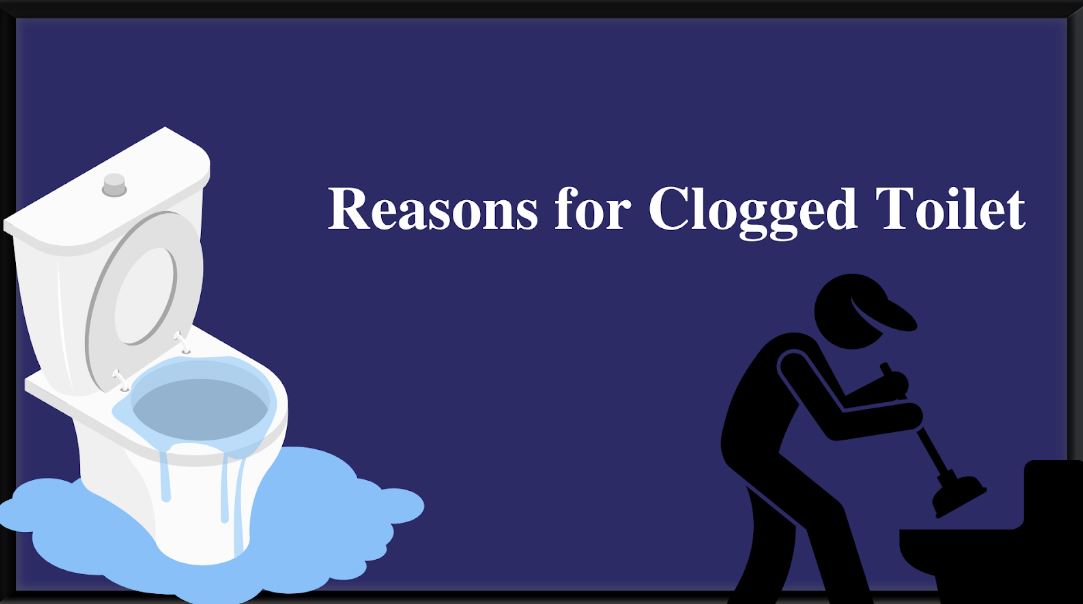Seeing your toilet clogging can make you start panicking. This is because of how valuable a toilet is to any home. But, there’s no reason to panic any time you find your toilet clogged. It is primarily a result of a minor problem that can get rectified and the toilet made to work again.
But, there’s a lot you should know about toilets and why they clog. You should know the causes of clogging and learn how to prevent clogging in the future. This will help ensure your toilet remains in working condition always. This article will look into why your toilet might clog. Let’s get started with it.

What Causes the Clogging?
Toilet clogging happens due to various reasons. Knowing these reasons will help you avoid clogging your toilet. It will ensure you address this problem by preventing it. So, before we go into how to fix a clogged toilet, why do toilets clog? Here are some of the reasons for clogging:
Using Too Much Toilet Paper
One of the biggest reasons for toilet clogging is using too much toilet paper. Yes, toilet paper is one of things you can safely flush. But, trying to flush too much of it can lead to clogging. It will help you learn the best ways to prevent clogging if you usually use too much toilet paper.
One way to do it is by flushing the toilet twice. Or, you can switch to a thicker tissue paper, so you don’t use too much of it. But should the paper clog your toilet, all you’ll need is a good toilet plunger to help clear it. The reality is that toilet paper clogs are some of the easiest to clear.
Issues with the Main Sewer Line
You can also experience clogging if the main sewer line has a problem. Clogging can result from having a sewer line that’s too old. Waste can build up over time and cause your toilet to clog. It can even get severe and cause multiple toilets in your home to clog.
This might require an expert plumber to help. You can unclog your toilet with Hoffmannbro’s, who are licensed plumbers. They’ll help diagnose your entire sewer system and identify where the clogging starts. Then, they’ll ensure your main sewer line is working optimally.
Putting Non-Flushable Objects Down the Toilet
Non-flushable items shouldn’t come anywhere near your toilet. Foreign objects that cannot disintegrate when flushed can make your toilet clog. Kids love playing, and they might flush items down the toilet. These items might get flushed but get stuck somewhere in the pipes.
This will cause a build-up of debris, and your toilet will clog. Thus, you should ensure only human waste and toilet paper get flushed into the toilet. Educate your kids about it and ensure they keep items like toys away from the toilet.
Slow Moving Septic System
Sometimes your septic system might be slow or lagging. This is another common cause of toilet clogging. A healthy sewer system usually has a quick turnover. One of the reasons your sewer system might be slow is the low pressure in the septic tank.
The best way to ensure your septic system works perfectly is by pumping it. Regular pumping will ensure that your septic system flows without any issues. Also, you might have to clean your septic tank regularly. Cleaning it every three years will keep it in perfect condition.
Issues with Toilet Itself
Sometimes the problem causing clogging is the toilet itself. You also need to check if your toilet is working well. Most old-generation toilets have a low-flush nature. This makes them more susceptible to low water pressure issues that might also cause clogging.
Besides, old toilets do not have enough power to flush waste and toilet paper. With time the waste that’s not getting fully pushed down the drain starts building up. Modern toilets have all you need to ensure your toilet doesn’t clog. They provide enough pressure while saving water.
Hard Water Problems
You might be wondering how hard water can cause clogging. Well, it is the chemicals it contains that cause clogging. Hard water contains calcium and magnesium. Deposits of these chemicals can build up in the pipes, making it easy for the system to clog.
You might find it difficult to unclog such a system using a toilet unclogger. The best way to do it is by working with a plumber to help you. Also, you might want to ensure you curb this issue once and for all. The best way to do this is by installing a water softener in your home.
Fill Valve Issues
The fill valve might also be a source of clogging issues. This part of the toilet ensures there’s sufficient water in the toilet tank. There won’t be enough water for flushing if this toilet part fails. Hence, waste and toilet paper might start building up in the pipes.
Thus, it would be best to always keep an eye on the fill valve. Also, ensure that no water is leaking and also do other checks. If the fill valve is faulty, consider replacing it with a new one immediately.
There’s Not Enough Water in the Tank
We’ve said that a faulty fill valve might make it challenging to have enough water. This can make it challenging to flush toilet waste into the sewer. There are also many other reasons why there might not be enough water in the toilet tank.
Thus, you should ensure you check what’s causing insufficiency. Then correct the issue to ensure you keep the water in the tank at the correct levels so that there’s enough pressure.
How to Prevent Future Clogs
Something else that’s worth knowing is how to prevent future clogs. You might work so hard to stop your toilet from clogging. But that doesn’t mean that it will never clog. You should ensure you prevent it from happening. Here’s how you can avoid toilet clogging in the future.
Awareness of How Your Toilet Works
One of the best steps to preventing clogging is knowing how your toilet works. It would be best to ask questions when the plumber installs the sewer system and toilet. Ask where the pipes are and where they converge. Learn the parts of the toilet to ensure you identify the problem quickly.
Practice Mindful Flushing
Many people do not know how best to flush their toilets. Proper flushing will make it easy for you to prevent clogging. We’ve mentioned before that you shouldn’t flush foreign objects down the toilet. Also, please do not use more than enough toilet paper because it might also lead to clogging.
Regular Cleaning
You also need to clean your sewer system and toilet regularly. Cleaning the toilet, for instance, makes it easy to spot the leaking points and seal them. Also, it can help clear any debris that’s building up in the pipes. In the end, it makes it easier to keep the toilet in working condition.
Conduct Inspections
The best way to know your system is working well is by inspecting it. You should inspect the whole sewer system regularly. This will help you notice issues before they become severe. It will also ensure you correct these issues early enough. Try conducting inspections twice every year.
Use the Double-Flush
Flushing the toilet twice can help prevent clogging. This is if it is an old-generation toilet that cannot generate sufficient pressure. You can flush the waste in the first round and then flush the used toilet paper in the second. This will make it easier to flush everything.
Avoid Chemical Drain Cleaners
Drain cleaners can help ensure the pipes we use are working well. But some of them are too strong and don’t serve their purpose well. Instead, they damage the hardware and make pipes shrink. This makes it difficult for everything to get through the pipes after you flush.
Clear the Tanks
Many people do not know how important it is to clear the toilet tanks. Instead, they use them as extra space for storing various items. Do not place any objects on top of the toilet tanks. You should have designated storage for tissue paper, brushes, and many other items.
Those are the ways to prevent your toilet from clogging. You now know the steps to follow if looking for a home remedy for a clogged toilet. These tips will ensure clogging doesn’t happen again if it is an issue you have been dealing with before.
Conclusion
A clogged toilet can cause discomfort at home or anywhere. But toilet clogging is preventable, so it is better to ensure it doesn’t happen. This is in contrast to starting to fix a clogged toilet. Now you know how you can prevent your toilet from clogging and how you can unclog a toilet.
This article has also provided insight into the causes of clogging. It has provided answers to the question, “why does my toilet keep clogging?” You can use the tips shared to unclog your toilet and prevent future instances. You can also work with experts who can help you unclog a toilet.












